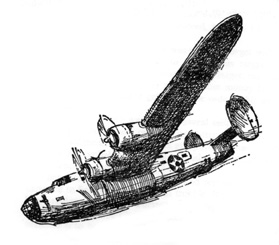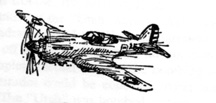Biographical Notes, Cont.Relating to Ancil D. Baker
|
||||||||||||
“From a ranch southwest of town I drove to high school where I spent my freshman year and met Genevieve who had moved there from Olathe, Kansas. So I and she have known each other 73 years and have been married 63 of them. |
||||||||||||
| “While a sophomore, Genevieve got a job with Southwestern Bell Telephone Company as a switchboard operator and kept it throughout the depression years. |
 |
|||||||||||
| “In June, 1932 I rode a Greyhound Bus to Nezperce, Idaho and spent the summer working for the Forest Service as a mule packer out of the Pete King Ranger Station on the Locksa River in the old Selway National Forest. It was a bad forest fire season and I spent most of my time packing sleeping bags, groceries and tools to fire fighters.” |
||||||||||||
| “In September I moved on up to Moscow and enrolled in the University of Idaho School of Forestry, majoring in logging engineering and pursuing advanced R.O.T.C. “Summers were spent working in the Coeur d' Alene National Forest, first as a lookout and finally as a packer with an eleven-mule pack string supplying lookouts and work camps. “In the spring of 1936 my Professor of Military Science and Tactics asked me ‘why didn't I apply for Flying School.’ I said, "What is Flying School?" I think he knew how destitute I was, financially.” |
||||||||||||
 |
||||||||||||
| “In June, while at Ft. George Wright, Spokane, Washington, in R.O.T.C summer camp, I was enlisted as Flying Cadet Baker, Ancil D. and rode trains to the Army Air Corps Flying Training School at Randolph Field, San Antonio, Texas. “My first tactical assignment was to the 13th Attack Squadron, Barksdale Field, Shreveport, Louisiana. Our doctrine was to fly around any cow en route, never over it. First Lieutenant Frank Armstrong was my flight leader. |
||||||||||||
 |
||||||||||||
| “After a couple of years the single-engine A-17a attack airplanes were replaced by twin-engine A-18, B-10, B-12 and B-18 bombers and the nations cows, chickens and horses got a respite. “In the summer of 1939 I flew our Army Air Corps American Indian Colonel, Clarence Tinker, to Tampa, Florida to view the vast palmetto palm field and resident rattlesnakes that soon became his new command, McDill Field. “I was fascinated by the experimental test work for whichWright Field was responsible. “In 1940 I accepted an offer to join a Wright Field Cold Weather Test Detachment being organized at Fairbanks, Alaska. |
||||||||||||
| “The only way to get there was by Army Transportation Corps passenger ship, the ‘San Michael’ from Fort Mason to Seward then by overnight steam-engine train to Fairbanks early in September 1940. General Simon Bolivar Buckner's wife and bird dogs were fellow passengers as far as Anchorage. |
||||||||||||
 |
||||||||||||
| “Major Gaffney, his adjutant, and his flight surgeon were the only Air Corps officers there. Quartermaster Construction Corps of Engineers, Captain Little, was the only other officer. “Other than by mail, the only communication with the outside world was by us army signal corps dots and dashes. “The only military airplane there was an 0-38 observation plane which had been shipped by boat and rail and reassembled at the bush-pilot's local Weeks Field Airport. It has been restored and is now on display in the Air Museum at Wright Field, Dayton, Ohio. “In October the runway at Ladd Field was ready for use and the 0-38 was moved over there. Soon thereafter two B-17As arrived and with the help of the local bush pilots cold weather testing really got under way. |
||||||||||||
| “Landing fields were completed in western Canada and smaller aircraft could then be flown to Ladd Field. |
||||||||||||
 |
||||||||||||
| “To parties, ladies wore ski pants under their gowns. Then, on 7 December, 1940 all dependents were ordered by the army to get out of the Territory of Alaska. Most of the Air Corps dependents were flown by their husbands to Juneau to board Alaska Steamship Company passenger ships to Seattle. Genevieve went to Spokane. |
||||||||||||
|
Gil Walker |
||||||||||||
|
or Go to Intro. Page or Pages 1 — 2 — 3 or Or you may go to Home - Contact Us - Cold War Hist. - 91st SRS Hist. - Stardust 40 Mission Story |
||||||||||||